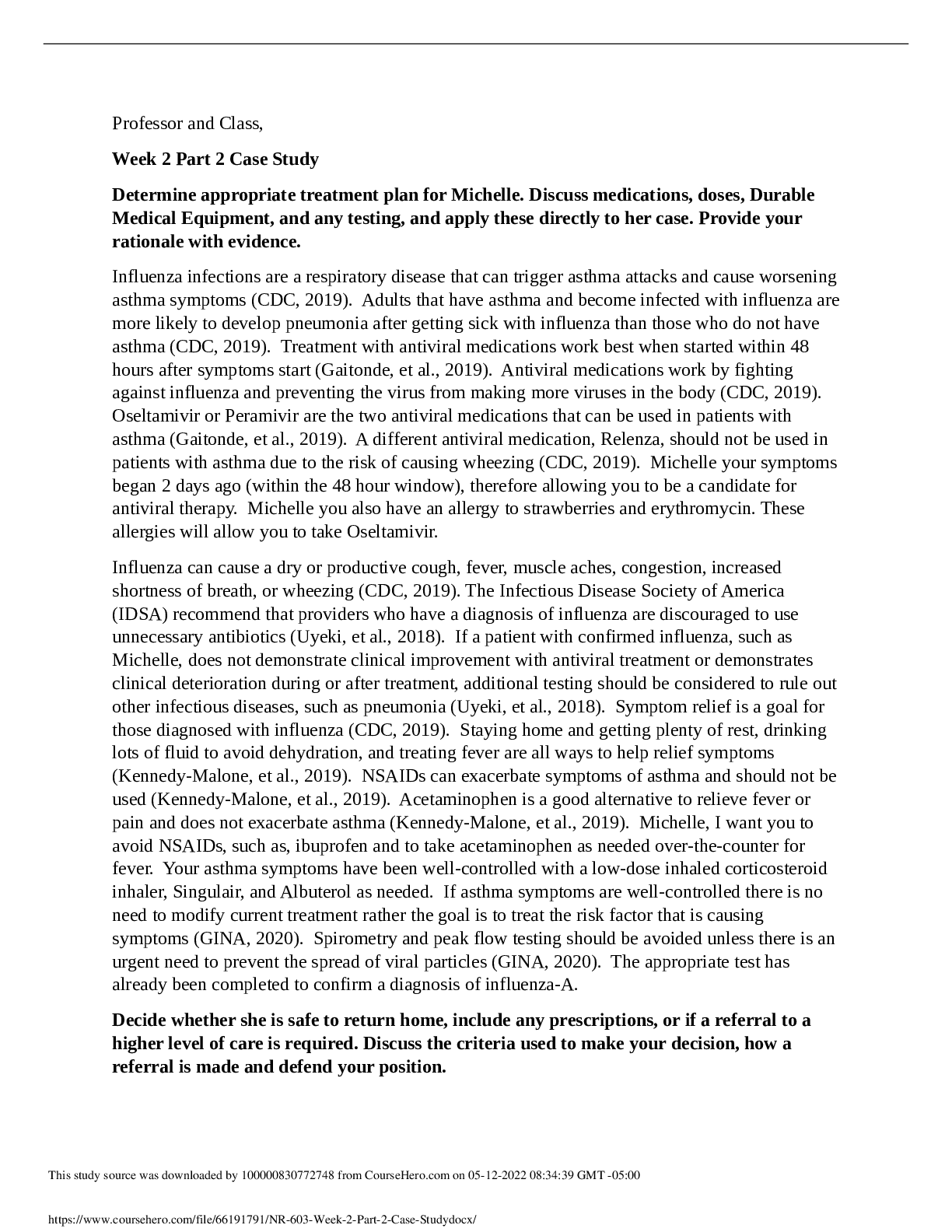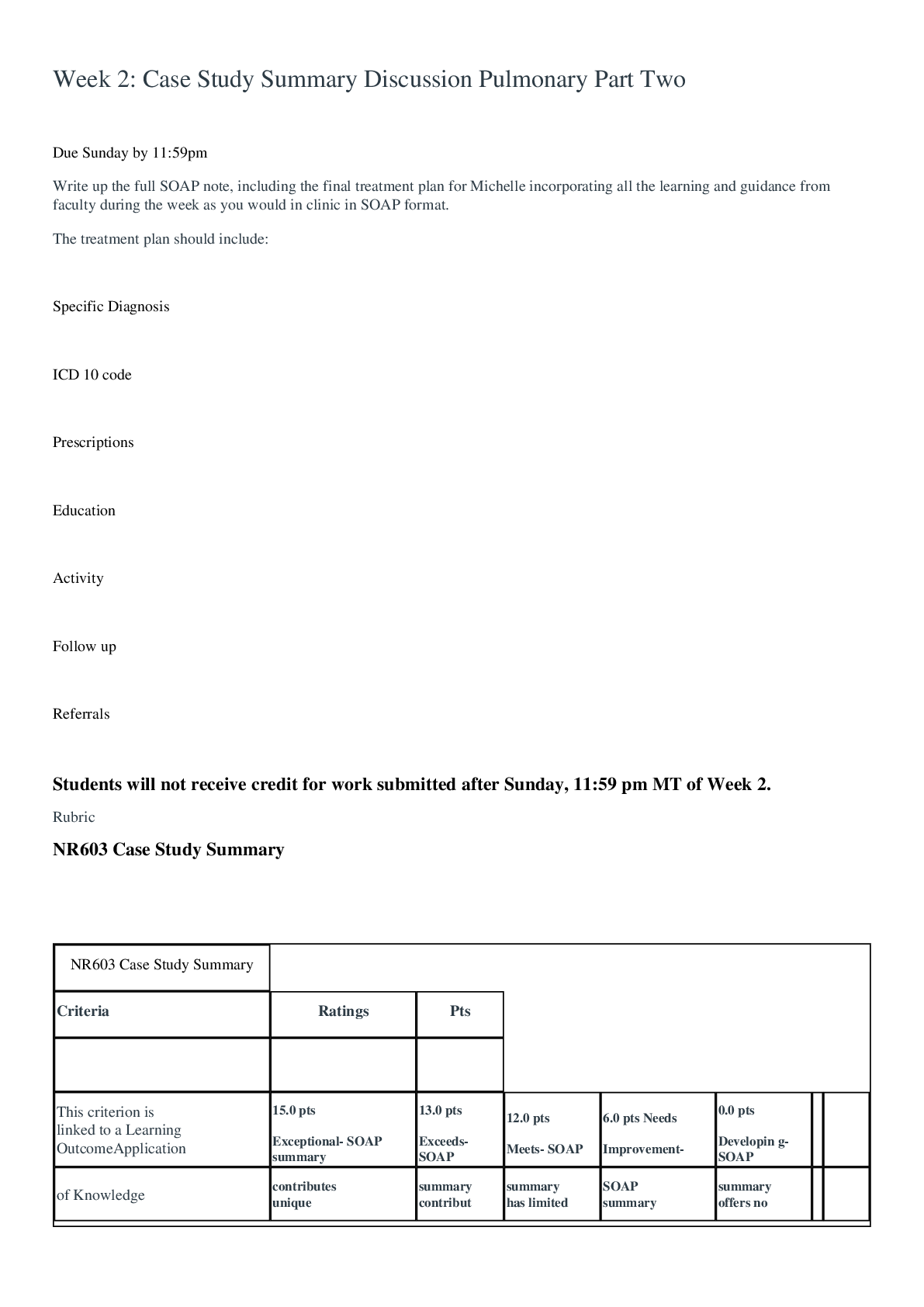Health Care > CASE STUDY > Case Study NR 601 – Week 2 part one NR601 (All)
Case Study NR 601 – Week 2 part one NR601
Document Content and Description Below
1. Briefly and concisely summarize the history and physical (H&P) findings as if you were presenting it to your preceptor using the pertinent facts from the case. Use shorthand where possible and ap... proved medical abbreviations. Avoid redundancy and irrelevant information HPI Pt is a 62-year-old male with a CC of persistence cough X 6 months and acute onset SOB. He describes the cough as intermittent but more frequent in the AM. He characterizes his cough as productive with white-yellow phlegm c/o. He identifies activity as an aggravating factor and has experienced some relief with rest but has tried Robitussin DM with no relief from symptoms. He denies chest pain, however he states that he has a decrease in activity tolerance in the last year stating that he isn’t able to go more then 20 feet without stopping for breath. Pertinent PMH He has a history of primary hypertension and takes 50mg metoprolol succinate ER daily along with a multivitamin. He is has an allergy to PNC accompanied by a rash. He has a hx of smoking cigarettes 20 packs a year when he quite “cold turkey” after the death of his father. No illicit drugs or alcohol use. He is married with 2 children and works as an accountant at a risk management firm. His family hx includes the death of his father at 59 due to CHF and MI. His father also suffered from diabetes, hypertension and smoking. His mother is still living and has osteoporosis and his siblings are living and healthy. Pertinent ROS findings: The patient is + for persistent cough in AM x 6 months. + for productive whitish, yellow phlegm. +SOB with activity. He is - for fever, chills, or weight loss. He is also - for otalgia, otorrhea, rhinorrhea, congestion, sneezing or PND. He is - for ST or redness, lymph node tenderness, or swelling, chest pain, or LE edema. Pertinent PE findings: Adult male, who is he is AAOx3, in NAD, + for complete sentences. Temp, RR, P are normal. Patient is + for Obesity with BMI of 39.24. +for elevated BP at 156/94. +normocephalic. + patent nares, + clear nasal turbinates, +clear nasal drainage bilaterally, - redness, - edema, OP + moisture, - exudate or lesions. +tonsils at ¼, +normal dentation. Neck -for thyromegaly, lymphadenopathy, or masses, - JVD. Heart sounds with +S1 and S2, -murmurs. +clear lung sound bilaterally, -labored breathing. + faint forced expiratory wheezes bilaterally in the bases. – labored respirations. -for lower extremity edema bilaterally. Abdomen is + softness, -organomegaly, - abdominal tenderness. 2. Provide a differential diagnosis (minimum of 3) which might explain the patient's chief complaint along with a brief statement of pathophysiology for each. This study source was downloaded by 100000840275362 from CourseHero.com on 06-26-2022 02:21:04 GMT -05:00 https://www.coursehero.com/file/60217497/Week-2-case-study-part-1-NR601docx/ Diagnosis #1 Chronic Obstructive Pulmonary Disease (COPD) Pathophysiology statement – The pathophysiology of COPD is complex but ultimately results in obstruction in the airway caused by damage to the pulmonary lumen, airway wall, or the structures that support the surrounding airway (Hammer & McPhee, 2019). Damage to the airway either by cigarette smoking, or by inhaling chemicals causes scarring of the airway structures (Hammer & McPhee, 2019). COPD caused by cigarette smoking is also known as emphysema and is thought to be caused by the chronic inflammation and tissue damage that occurs due to exposure to noxious chemicals (Hammer & McPhee, 2019). The scarring of the structures causes a loss in the elastin-containing alveolar structures which decreases the mailability of the alveoli. This decrease in elasticity allows air molecules to enter the alveoli and hyperinflation causes a decrease in the recoil of alveoli and their ability to refill with air molecules and exchange oxygen. As a result of this cascade, the airways prematurely collapse and cause airway obstruction (Hammer & McPhee, 2019). The chronic inflammation and the immune mediated inflammatory response causes an increase in phlegm production and chronic bronchitis occurs. Diagnosis #2 Mild asthma with acute exacerbation Pathophysiology statement – Asthma is the result of multiple factors that has several phenotypes (Hammer & McPhee, 2019). An airway disease, the pathophysiology of asthma is not completely understood. Thought to be an autoimmune mediated response by cytokine release, asthma is caused by exposure to allergens or other stimuli that causes a cellular cascade of inflammation. The constant cellular cascade of inflammation can decrease muscle tone in the lung tissue, narrowing the airway pathways due to inflammation and an increase in secretions (Hammer & McPhee, 2019). The constant inflammation process can continue to damage tissue and continue to erode the airways structures of the lungs causing a decrease in the body’s ability to take in air or expel air for gas exchange (Hammer & McPhee, 2019). Diagnosis #3 Congestive heart failure Pathophysiology statement – Congestive heart failure (CHF) is most commonly caused by longstanding, uncontrolled hypertension and is extremely complex and multifactorial (Hammer & McPhee, 2019). Left sided heart failure is the most common form of CHF. In most cases, CHF is caused when the left side of the heart is unable to circulate blood to the extremities due to obstruction due to increase blood pressure. This increase in pressure causes and increase in the stroke volume of heart. Over time, the left side of the heart enlarges due to increased muscle fiber creation and a decrease in left side heart chamber size. The body is then unable to properly pump oxygenated blood to the extremities and the heart must work even harder to circulate the blood (Hammer & McPhee, 2019). This feedback loop continues and the heart continues to remodel creating more muscle fibers and increasing the workload of the heart further. The increased work load to the heart creates “leaky” blood vessels due to the rise in pressure causing fluid to leak into the interstitial tissues of the lower extremities and lungs (Hammer & McPhee, 2019). This study source was downloaded by 100000840275362 from CourseHero.com on 06-26-2022 02:21:04 GMT -05:00 https://www.coursehero.com/file/60217497/Week-2-case-study-part-1-NR601docx/ 3. Analyze the differential by using the pertinent findings from the history and physical to argue for or against a diagnosis. Diagnosis #1 – COPD The primary diagnosis I have chosen is COPD. The symptoms of COPD include shortness of breath, activity intolerance, chronic cough, clear or yellow tinged secretion with a previous history of smoking, exposure to noxious chemicals or fumes (Domino, Baldor, Golding, & Stephens, 2019). Other symptoms include decreased breath sounds, expiratory wheezes and prolonged expiration (Papadakis, McPhee, & Rabow, 2019). COPD is also seen in patients over the age of forty. Positive findings – He is positive for chronic cough x 6 months, with acute SOB with activity, progressive decline in activity tolerance, productive whitish/yellow sputum, history of smoking and 52 years old. He has tried OTC remedies for his cough that have not improved his condition (Domino et al., 2019). He is also positive for faint forced expiratory wheezes bilaterally in the bases of his lungs. Negative findings – He has no other signs or symptoms for a possible viral or bacterial infection as the cause of his productive cough (Domino et al., 2019). He is negative for boggy turbinates, abnormal nasal discharge bilaterally, or nasal redness or edema, fever or chills. He has no relief in his symptoms by using OTC cough suppressant (Hammer & McPhee, 2019). He is also negative for PND, otalgia, otorrhea, rhinorrhea, congestion or sneezing. His lungs are clear bilaterally to auscultation and his O2 saturation at room air is within normal range (Domino et al., 2019). Diagnosis #2 Asthma with acute exacerbation The secondary diagnosis I have chosen is Asthma. While asthma is considered an obstructive airway disease, the major defining characteristic is that is typically immune mediated and doesn’t have a slow increase in progression when compared with COPD (Papadakis et al., 2019). Another defining difference is that it is typically triggered by pollen, cold, exercise or animal dander and is accompanied with chest tightness, pain or pressure and inspiratory and expiratory wheezes and normal respirations in between attacks (Papadakis et al., 2019). Positive findings – He has faint forced expiratory wheezes bilaterally in the bases with a productive cough and acute SOB with activity (Domino et al., 2019). Negative finding – He is negative for inspiratory wheezing, acute cough with return to normal breathing which is a common symptom of asthma (Papadakis et al., 2019). He is negative for allergy’s or previous diagnosis of asthma and his O2 saturation at room air is within normal range He is also negative for chest tightness or chest pain, he is a smoker, and he is over the age of 40 with a progressive decline in activity tolerance. [Show More]
Last updated: 2 years ago
Preview 1 out of 5 pages

Buy this document to get the full access instantly
Instant Download Access after purchase
Buy NowInstant download
We Accept:

Reviews( 0 )
$7.00
Can't find what you want? Try our AI powered Search
Document information
Connected school, study & course
About the document
Uploaded On
Jun 26, 2022
Number of pages
5
Written in
Additional information
This document has been written for:
Uploaded
Jun 26, 2022
Downloads
0
Views
394









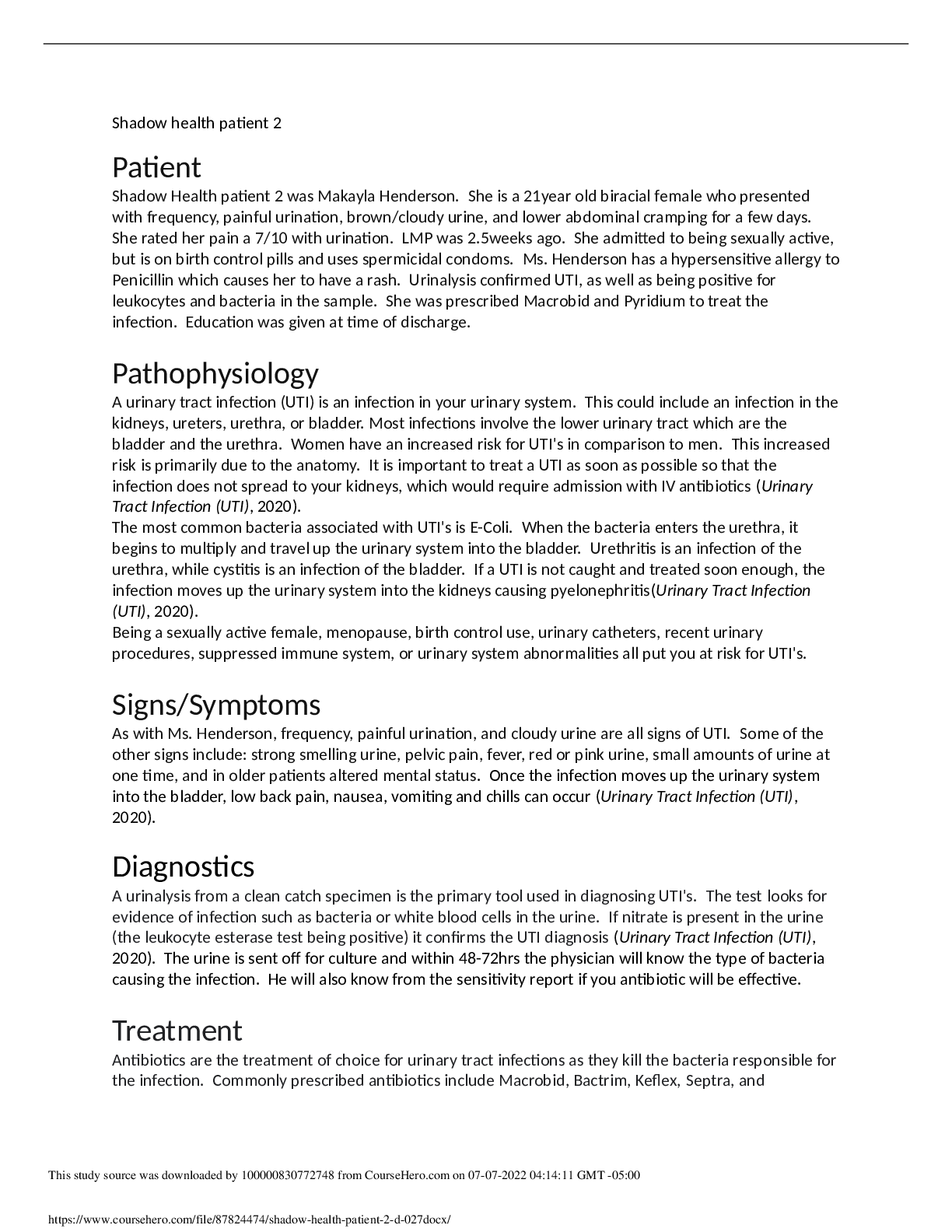


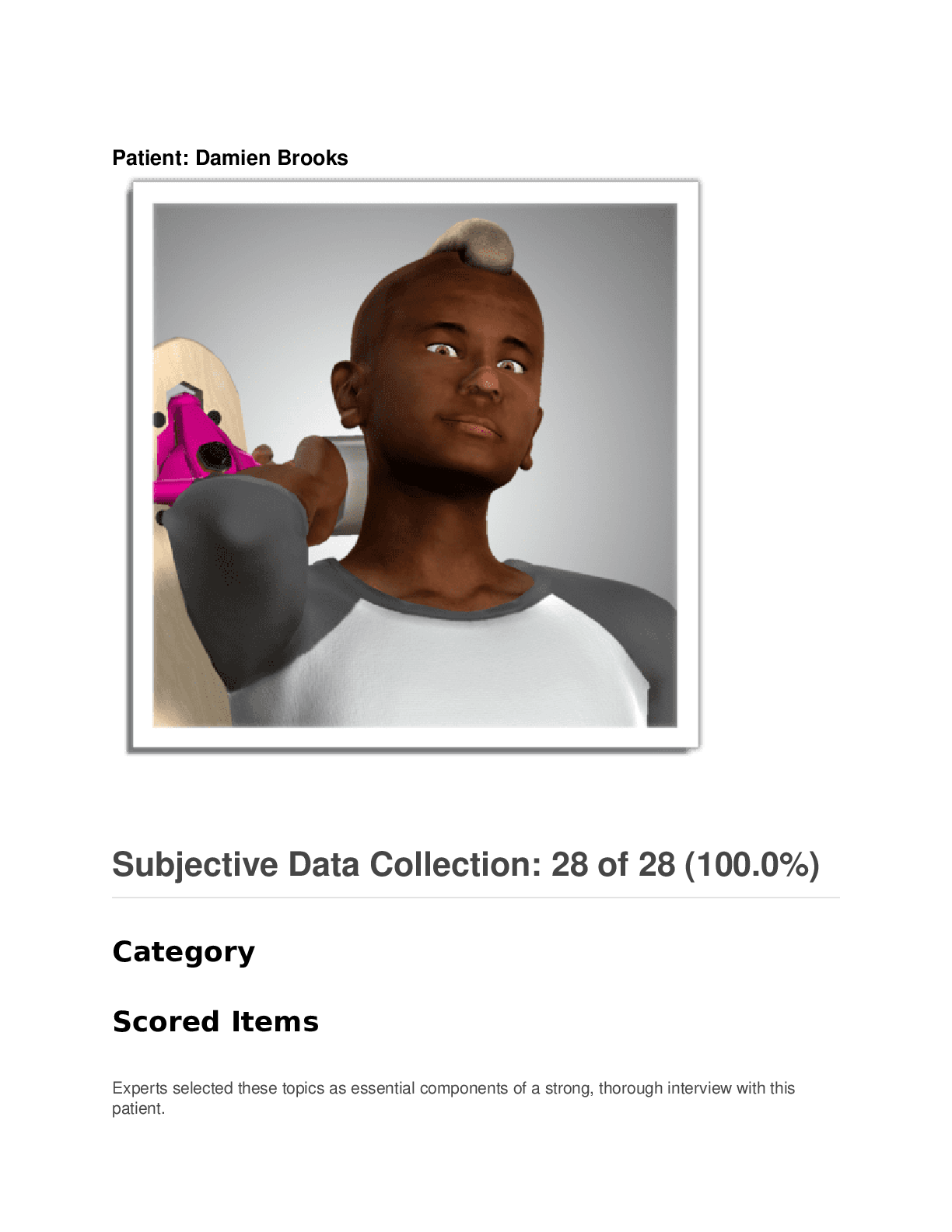

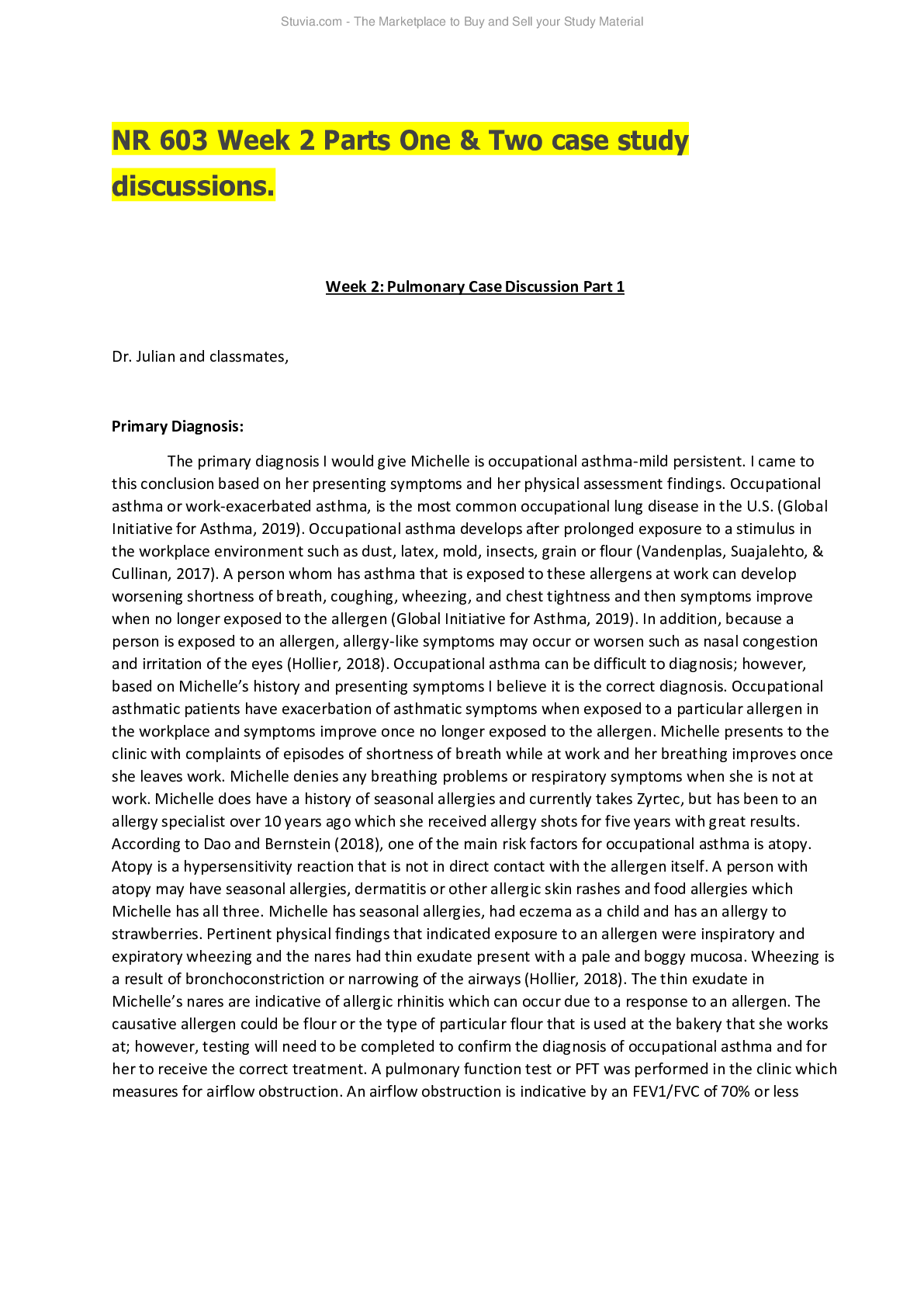
.png)
